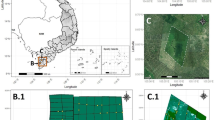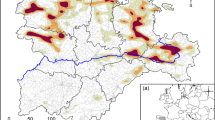Abstract
The extensive use of anticoagulant rodenticides (ARs) results in widespread unintentional exposure of non-target rodents and secondary poisoning of predators despite regulatory measures to manage and reduce exposure risk. To elucidate on the potential vectoring of ARs into surrounding habitats by non-target small mammals, we determined bromadiolone prevalence and concentrations in rodents and shrews near bait boxes during an experimental application of the poison for 2 weeks. Overall, bromadiolone was detected in 12.6% of all small rodents and insectivores. Less than 20 m from bait boxes, 48.6% of small mammals had detectable levels of bromadiolone. The prevalence of poisoned small mammals decreased with distance to bait boxes, but bromadiolone concentration in the rodenticide positive individuals did not. Poisoned small mammals were trapped up to 89 m from bait boxes. Bromadiolone concentrations in yellow-necked mice (Apodemus flavicollis) were higher than concentrations in bank vole (Myodes glareolus), field vole (Microtus agrestis), harvest mouse (Micromys minutus), and common shrew (Sorex araneus). Our field trials documents that chemical rodent control results in widespread exposure of non-target small mammals and that AR poisoned small mammals disperse away from bating sites to become available to predators and scavengers in large areas of the landscape. The results suggest that the unintentional secondary exposure of predators and scavengers is an unavoidable consequence of chemical rodent control outside buildings and infrastructures.


Similar content being viewed by others
References
Albert CA, Wilson LK, Mineau P, Trudeau S, Elliott JE (2010) Anticoagulant rodenticides in three owl species from Western Canada, 1988-2003. Arch Environ Contam Toxicol 58:451–459
Alomar H, Chabert A, Coeurdassier M, Vey D, Berny P (2017) Accumulation of anticoagulant rodenticides (chlorophacinone, bromadiolone and brodifacoum) in a non-target invertebrate, the slug, Deroceras reticulatum. Sci Total Environ 610-611:576–582
Alterio N, Brown K, Moller H (1997) Secondary poisoning of mustelids in a New Zealand Nothofagus forest. J Zool 243:863–869
Berny P, Gaillet J-R (2008) Acute poisoning of red kites (Milvus milvus) in France: data from the SAGIR network. J Wildl Dis 44:417–426
Booth IF, Fisher P, Heppelthwaite V, Eason CT (2003) Toxicity and residues of brodifacoum in snails and earthworm. Department of Conservation, DOC Science Internal Series 143, Wellington
Brakes CR, Smith RH (2005) Exposure of non-target small mammals to rodenticides: short-term effects, recovery and implications for secondary poisoning. J Appl Ecol 42:118–128
Burnham KP, Anderson DR, Huyvaert KP (2011) AIC model selection and multimodel inference in behavioral ecology: some background, observations, and comparisons. Behav Ecol Sociobiol 65:23–35
Carlsen M (1993) Migrations of Mus musculus musculus in Danish farmland. Z Säugetierkd 58:172–180
Christensen TK, Lassen P, Elmeros M (2012) High exposure rates of anticoagulant rodenticides in predatory bird species in intensively managed landscapes in Denmark. Arch Environ Contam Toxicol 63:437–444
Coeurdassier M, Riols R, Decors A, Mionnet A, David F, Quintaine T, Truchetet D, Scheifler R, Giraudoux P (2014) Unintentional wildlife poisoning and proposals for sustainable management of rodents. Conserv Biol 28:315–321
Coeurdassier M, Fritsch C, Jacquot M, van den Brink N, Giraudoux P (2018) Spatial dimension of the risks of rodenticide use to non-target small mammals and applications in spatially explicit risk modeling. In: van den Brink N, Elliott J, Shore R, Rattner B (eds) Anticoagulant rodenticides and wildlife. Springer Publishers, Cham, pp 195–227
Cox P, Smith RH (1992) Rodenticide ecotoxicology: pre-lethal effects of anticoagulants on rat behaviour. In: Borrecco JE, Marsh RE (eds) Proceedings of the 15th Vertebrate Pest Conference. University of California, Davis, pp 64–170
Dowding CV, Shore RF, Worgan A, Baker PJ, Harris S (2010) Accumulation of anticoagulant ro-denticides in a non-target insectivore, the European hedgehog (Erinaceus europaeus). Environ Pollut 158:161–166
Eason CT, Spurr EB (1995) Review of the toxicity and impacts of brodifacoum on non-target wildlife in New Zealand. N Z J Zool 22:371–379
Eason CT, Murphy EC, Wright GRG, Spurr EB (2002) Assessment of risk of brodifacoum to non-target birds and mammals in New Zealand. Ecotoxicology 11:35–48
Elliott JE, Hindmarch S, Albert CA, Emery J, Mineau P, Maisonneuve F (2014) Exposure pathways of anticoagulant rodenticides to nontarget wildlife. Environ Monit Assess 186:895–906
Elmeros M (2006) Food habits of stoats Mustela erminea and weasels Mustela nivalis in Denmark. Acta Theriol 51:179–186
Elmeros M, Birch MM, Madsen AB, Baagøe HJ, Pertoldi C (2008) Skovmårens biologi og levevis i Danmark. Scientific report no. 692, National Environmental Research Institute, Aarhus University, Aarhus
Elmeros M, Christensen TK, Lassen P (2011) Concentrations of anticoagulant rodenticides in stoats Mustela erminea and weasels Mustela nivalis from Denmark. Sci Total Environ 409:2373–2378
Elmeros M, Lassen P, Bossi R, Topping CJ (2018) Exposure of stone marten (Martes foina) and polecat (Mustela putorius) to anticoagulant rodenticides: effects of regulatory restrictions of rodenticide use. Sci Total Environ 612:1358–1364
Erickson W, Urban D (2004) Potential risks of nine rodenticides to birds and non-target mammals: a comparative approach. U.S. Environmental Protection Agency report. EPA Office of Pesticide Programs, Washington DC
European Food Safety Authority (2010) Conclusion on the peer review of the pesticide risk assessment of the active substance bromadiolone. EFSA J 8:1783. https://doi.org/10.2903/j.efsa.2010.1783
Fraser D, Mouton A, Serieys LEK, Cole S, Carver S, Vandewoude S, Lappin M, Riley SPD, Wayne R (2018) Genome-wide expression reveals multiple systemic effects associated with detection of anticoagulant poisons in bobcats (Lynx rufus). Mol Ecol 27:1–18
Geduhn A, Esther A, Schenke D, Mattes H, Jacob J (2014) Spatial and temporal exposure patterns in non-target small mammals during brodifacoum rat control. Sci Total Environ 496:328–338
Geduhn A, Esther A, Schenke D, Gabriel D, Jacob J (2016) Prey composition modulates exposure risk to anticoagulant rodenticides in a sentinel predator, the barn owl. Sci Total Environ 544:150–157
Gómez JM, Puerta-Piñero C, Schupp EW (2008) Effectiveness of rodents as local seed dispersers of Holm oaks. Oecologia 155:529–537
Hammershøj M, Thomsen EA, Madsen AB (2004) Diet of free-ranging American mink and European polecat in Denmark. Acta Theriol 49:337–347
Lemus JA, Bravo C, García-Montijano M, Palacín C, Ponce C, Magaña M, Alonso JC (2011) Side effects of rodent control on non-target species: rodenticides increase parasite and pathogen burden in great bustards. Sci Total Environ 409:4729–4734
Love R, Webbon C, Glue DE, Harris S (2000) Changes in the food of British barn owls (Tyto alba) between 1974 and 1997. Mammal Rev 30:107–129
Macdonald DW, Tew TE, Todd IA, Garner JP, Johnson PJ (2000) Arable habitat use by wood mice (Apodemus sylvaticus). 3. A farm-scale experiment on the effects of crop rotation. J Zool 250:313–320
Madsen SA, Madsen AB, Elmeros M (2002) Seasonal food of badgers (Meles meles) in Denmark. Mammalia 66:341–352
Montgomery WI (1989) Population regulation in the wood mouse, Apodemus sylvaticus. II. Density dependence in spatial distribution and reproduction. J Anim Ecol 58:477–494
By- og Landskabsstyrelsen (2010) Plan for fokuseret forebyggelse og bekæmpelse af rotter i Danmark. By- og Landskabsstyrelsen, Miljøministeriet, Copenhagen (in Danish)
Pocock MJO, Hauffe H, Searle JB (2005) Dispersal in house mice. Biol J Linn Soc 84:565–583
Rattner BA, Lazarus RS, Elliott JE, Shore RF, van den Brink N (2014) Adverse outcome pathway and risks of anticoagulant rodenticides to predatory wildlife. Environ Sci Technol 48:8433–8445
Ruiz-Suarez N, Melero Y, Giela A, Henriquez-Hernandez LA, Sharp E, Boada LD, Taylor MJ, Camacho M, Lambin X, Luzardo OP, Hartley G (2016) Rate of exposure of a sentinel species, invasive American mink (Neovison vison) in Scotland, to anticoagulant rodenticides. Sci Total Environ 569:1013–1021
Sage M, Coeurdassier M, Defaut R, Gimbert F, Berny P, Giraudoux P (2008) Kinetics of bromadiolone in rodent populations and implications for predators after field control of the water vole, Arvicola terrestris. Sci Total Environ 407:211–222
Sainsbury KA, Shore RF, Schofield H, Croose E, Pereira MG, Sleep D, Kitchener AC, Hantke G, McDonald RA (2018) Long-term increase in secondary exposure to anticoagulant rodenticides in European polecats Mustela putorius in Great Britain. Environ Pollut 236:689–698
Sandell M, Agrell J, Erlinge S, Nelson J (1991) Adult philopatry and dispersal in the field vole Microtus agrestis. Oecologia 86:153–158
Serieys LE, Armenta TC, Moriarty JG, Boydston EE, Lyren LM, Poppenga RH, Crooks KR, Wayne RK, Riley SP (2015) Anticoagulant rodenticides in urban bobcats: exposure, risk factors and potential effects based on a 16-year study. Ecotoxicology 24:844–862
Shore RF, Birks JDS, Afsar A, Wienburg CL, Kitchener AC (2003) Spatial and temporal analysis of second-generation anticoagulant rodenticide residues in polecat (Mustela putorius) from throughout their range in Britain, 1992-1999. Environ Pollut 122:183–193
Stradiotto A, Cagnacci F, Delahay R, Tioli S, Nieder L, Rizzoli A (2009) Spatial organization of the yellow-necked mouse: effects of density and resource availability. J Mammal 90:704–714
Szacki J (1999) Spatially structured populations: how much do they match classic metapopulation concept? Landsc Ecol 14:369–379
Taylor KD (1978) Range of movement and activity of common rats (Rattus norvegicus) on agricultural land. J Appl Ecol 15:663–677
Topping CJ, Elmeros M (2016) Modeling exposure of mammalian predators to anticoagulant rodenticides. Front Environ Sci 4:80. https://doi.org/10.3389/fenvs.2016.00080
Tosh DG, McDonald RA, Bearhop S, Llewellyn NR, Montgomery I, Shore RF (2012) Rodenticide exposure in wood mouse and house mouse populations on farms and potential secondary risk to predators. Ecotoxicology 21:1325–1332
Townsend MG, Entwhistle P, Hart ADM (1995) Use of two halogenated biphenyls as indicators of non-target exposure during rodenticide treatments. Bull Environ Contam Toxicol 54:526–533
Vandenbrough V, Bouquet-Melou A, De Backer P, Croubels S (2008) Pharmacokinetics of eight anticoagulant rodenticides in mice after single oral administration. J Vet Pharmacol Therap 31:437–445
Wolton RJ, Flowerdew JR (1985) Spatial distribution and movements of wood mice, yellow necked mice and bank voles. Symp Zool Soc Lond 55:249–275
World Health Organization (WHO) (1995) Environmental health criteria 175: anticoagulant rodenticides. World Health Organization, Geneva
Acknowledgements
Jennifer Lynch, Jens Peder Hounisen, and Lars Haugaard provided invaluable technical and field assistance. We thank Charlotte Dahl Schiødt and Ellen Christiansen for laboratory assistance and the Danish Nature Agency for access to the field sites. We also thanks the reviewers for valuable comments on an earlier draft of the manuscript.
Funding
The study was funded by research grants from the Danish Environmental Protection Agency (MST 667-00100 and MST 667-00112).
Author information
Authors and Affiliations
Corresponding author
Ethics declarations
The field trials were done in accordance with a permit issued to the Department of Bioscience by the Danish Nature Agency: SN302-009SEI.
Conflict of interest
The authors declare that they have no conflict of interest.
Additional information
Responsible editor: Philippe Garrigues
Publisher’s Note
Springer Nature remains neutral with regard to jurisdictional claims in published maps and institutional affiliations.
Electronic supplementary material
Table S1
(DOCX 18 kb)
Rights and permissions
About this article
Cite this article
Elmeros, M., Bossi, R., Christensen, T.K. et al. Exposure of non-target small mammals to anticoagulant rodenticide during chemical rodent control operations. Environ Sci Pollut Res 26, 6133–6140 (2019). https://doi.org/10.1007/s11356-018-04064-3
Received:
Accepted:
Published:
Issue Date:
DOI: https://doi.org/10.1007/s11356-018-04064-3




